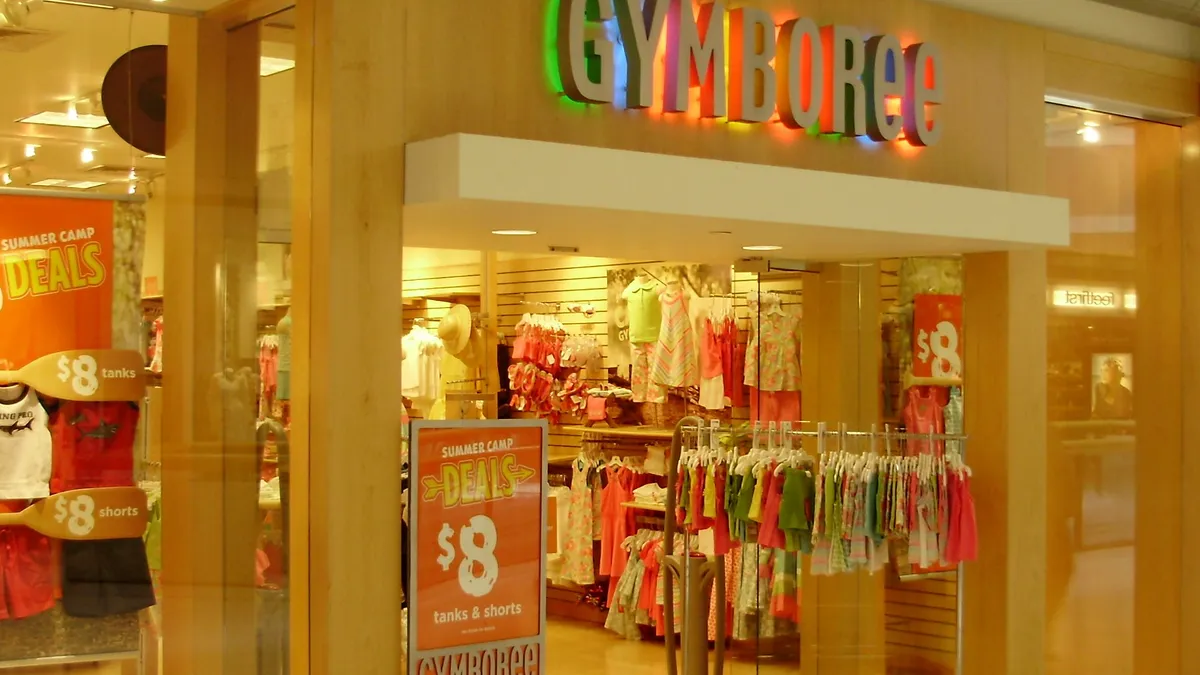Dive Brief:
- Gymboree announced Sunday that it has entered voluntarily into Chapter 11 bankruptcy to cope with a massive debt load that carried a looming maturity. On a company website related to the bankruptcy, which was filed in U.S. Bankruptcy Court for the Eastern District of Virginia, Gymboree told its customers and vendors that it would continue “business as normal” through the restructuring process.
- “The timing and final list of stores to be closed is still being determined,” the company said in a press release. Gymboree officials also said that the restructuring agreement would reduce the company’s debt by $900 million to “establish a sustainable capital structure.” It also provides for $35 million in debtor-in-possession financing, as well as up to $235 in additional financing from lenders under the company’s asset-backed loan facility.
- Gymboree also announced Chief Financial Officer Andrew North will step down for personal reasons. His role wil be taken over by Liyuan Woo, a director at AlixPartners, a consultancy specializing in corporate turnarounds. Debtwire and others reported Gymboree had hired AlixPartners in advance of the bankruptcy process.
Dive Insight:
Gymboree needed a lifeline, and it seems to have gotten one in the announced agreement with its lenders. The retailer has been struggling under its debt pile, which had become unsustainable as sales flagged and competition heated up from general merchandise retailers, off-pricers, e-retailers and fellow niche children’s apparel sellers like The Children’s Place and Carter’s.
To secure a place in the market with the debt load it inherited from Bain’s leverage buyout of the retailer in 2010, the company needed debt relief and working capital, and the company announced it had received both of those things in its agreement with its creditors.
For its part, Gymboree tried to project optimism amid the filing. “The steps we are taking today allow the company to definitively address its debt and enable the management team to turn its full focus toward executing our key strategies, including our product, brand and omnichannel initiatives,” Daniel Griesemer, Gymboree’s new CEO, said in a statement. Griesemer, who ran teen apparel retailer Tilly’s for about five years until 2015, joined Gymboree just weeks ahead of the filing. He took over the permanent chief executive position from current and former Gap Inc. executive Mark Breitbard, who left in January.
Fitch analysts said Monday in comments emailed to Retail Dive: “Fitch expects the chain to emerge as a smaller going concern following the closure of underperforming stores. While children’s apparel is available from a host of competitors… the company benefits from the continuing support of its sponsor, Bain Capital, and a plan to restore and grow brand value.” That said, Gymboree's bankruptcy prompted Fitch analysts to raise its default measure for the retail industry to 2.7% from 1.7%.
So far, Gymboree’s bankruptcy has played out as early reports suggested. Its creditors for now seem committed to keeping the company an ongoing concern with a retail footprint but have plans to restructure and regain profitability. “It fits with the mold of one of the most, if not the most likely ways this would play out,” Josh Friedman, a legal analyst with Debtwire, said in an interview. He noted that many of the company’s core stakeholders signed onto the agreement, including about two-thirds of the company’s term loan lenders as well as Bain. Not signing on were non-secured loan holders of Gymboree, who are likely to see much of their holdings wiped out, Friedman said.
Unanswered still is the ultimate store count that will get the axe amid restructuring. The company has so far said only a majority of its stores will remain open. With 1,300 stores, that statement, taken at face value, leaves open the possibility of more than 600 closures. However, in a court filing, James Mesterharm, Gymboree’s designated chief restructuring officer, said that the company anticipates closing at least 375 stores, given that about two-thirds of company’s stores contribute about 97% of its profit. In a separate filing Monday, Gymboree and other debtors put the target at up to 450 store closures, contingent on whether they can negotiate favorable leases and rent terms with landlords. The debtor group said they expect to complete lease negotiations and firm up a list of store closures by June 28.
Also uncertain for now are the various fates of Gymboree’s three lines of stores: its high-end Janie and Jack, it lower-priced Crazy 8 and its flagship Gymboree brand. David Silverman, senior director for retail coverage at Fitch, told Retail Dive in May that the three store brands were “cannibalizing” each other, and several analysts have anticipated that Gymboree might downsize or sell of the Crazy 8 brand, which has seen sales declines, in favor of expanding the more profitable Janie and Jack brand. With less information about store closures, Debtwire's Friedman said there’s no way to know whether the company is planning some sort of wind down for Crazy 8.
Perhaps the most important remaining question is whether a downsized Gymboree can sustain even its more modest market share in the face of growing competition and a disrupted retail environment. For now, Gymboree’s executives and owners are betting it can. But with the company closing potentially hundreds of stores, children’s retailers like Carter’s and The Children’s place will be looking for an opportunity in Gymboree’s bankruptcy.














